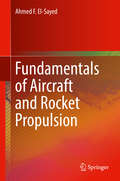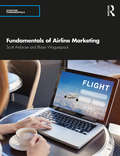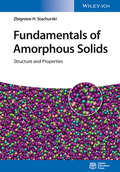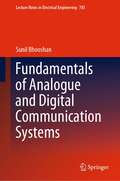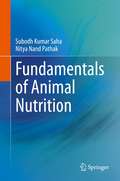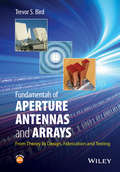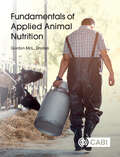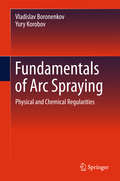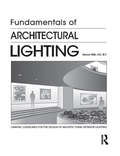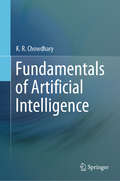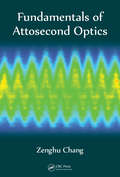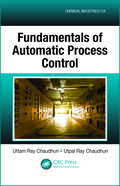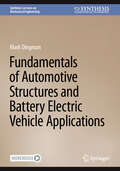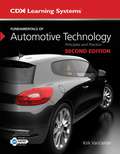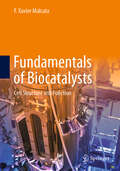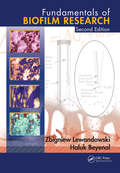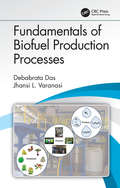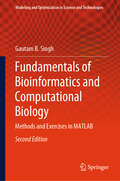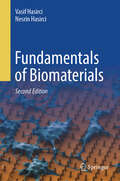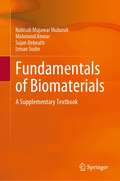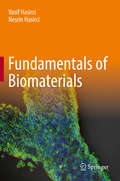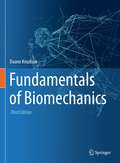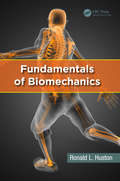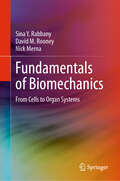- Table View
- List View
Fundamentals of Aircraft and Rocket Propulsion
by Ahmed F. El-SayedThis book provides a comprehensive basics-to-advanced course in an aero-thermal science vital to the design of engines for either type of craft. The text classifies engines powering aircraft and single/multi-stage rockets, and derives performance parameters for both from basic aerodynamics and thermodynamics laws. Each type of engine is analyzed for optimum performance goals, and mission-appropriate engines selection is explained. Fundamentals of Aircraft and Rocket Propulsion provides information about and analyses of: thermodynamic cycles of shaft engines (piston, turboprop, turboshaft and propfan); jet engines (pulsejet, pulse detonation engine, ramjet, scramjet, turbojet and turbofan); chemical and non-chemical rocket engines; conceptual design of modular rocket engines (combustor, nozzle and turbopumps); and conceptual design of different modules of aero-engines in their design and off-design state. Aimed at graduate and final-year undergraduate students, this textbook provides a thorough grounding in the history and classification of both aircraft and rocket engines, important design features of all the engines detailed, and particular consideration of special aircraft such as unmanned aerial and short/vertical takeoff and landing aircraft. End-of-chapter exercises make this a valuable student resource, and the provision of a downloadable solutions manual will be of further benefit for course instructors.
Fundamentals of Airline Marketing (Aviation Fundamentals)
by Scott Ambrose Blaise WaguespackApplying fundamentals of marketing to commercial passenger air transportation, this textbook puts the emphasis on marketing principles and illustrative ways in which airlines can distinguish themselves within the highly competitive global marketplace. Fundamentals of Airline Marketing begins with a survey of current airline business strategies and the macro forces that have shaped the airline industry in the past and will continue to do so in the future. The growing importance of technology is discussed both from the perspective of better understanding customer needs and engaging more effectively with them. The central role of the "customer" is explored through the lens of modern segmentation and branding approaches. Coverage then shifts to the tactical decision areas consisting of the 4Ps—product, place, promotion, and price—in which marketers shape and execute their strategies. The book concludes with a focus on executing marketing initiatives internally through customer-facing employee groups and externally through the measurement and management of the customer experience. Fundamentals of Airline Marketing: • is an accessible textbook on the fundamentals of marketing for commercial passenger air transportation; • chronicles the marketing innovations and controversies that have been central to the historic shift in airline fortunes; • demonstrates how airline decisions fit within the fundamentals of marketing and how the marketplace is continuing to evolve; • provides a bridge between key marketing principles and their specific application to the airline industry in each chapter. This textbook is written primarily for undergraduate college students enrolled in aviation business administration programs and related courses. It will also serve as an accessible primer on airline marketing for industry professionals not presently working in marketing and for frontline airline employees seeking to learn more about marketing.
Fundamentals of Amorphous Solids: Structure and Properties
by Zbigniew H. StachurskiLong awaited, this textbook fills the gap for convincing concepts to describe amorphous solids. Adopting a unique approach, the author develops a framework that lays the foundations for a theory of amorphousness. He unravels the scientific mysteries surrounding the topic, replacing rather vague notions of amorphous materials as disordered crystalline solids with the well-founded concept of ideal amorphous solids. A classification of amorphous materials into inorganic glasses, organic glasses, glassy metallic alloys, and thin films sets the scene for the development of the model of ideal amorphous solids, based on topology- and statistics-governed rules of three-dimensional sphere packing, which leads to structures with no short, mid or long-range order. This general model is then concretized to the description of specific compounds in the four fundamental classes of amorphous solids, as well as amorphous polyethylene and poly(methyl)methacrylate, emphasizing its versatility and descriptive power. Finally, he includes example applications to indicate the abundance of amorphous materials in modern-day technology, thus illustrating the importance of a better understanding of their structure and properties. Equally ideal as supplementary reading in courses on crystallography, mineralogy, solid state physics, and materials science where amorphous materials have played only a minor role until now.
Fundamentals of Analogue and Digital Communication Systems (Lecture Notes in Electrical Engineering #785)
by Sunil BhooshanThe book covers fundamentals and basics of engineering communication theory. It presents right mix of explanation of mathematics (theory) and explanation. The book discusses both analogue communication and digital communication in details. It covers the subject of ‘classical’ engineering communication starting from the very basics of the subject to the beginning of more advanced areas. It also covers all the basic mathematics which is required to read the text. It covers a two semester course as an undergraduate text and some topics in master’s course as well.
Fundamentals of Animal Nutrition
by Subodh Kumar Saha Nitya Nand PathakThe book provides comprehensive information about the different aspects of veterinary nutrition in tropical countries.The introductory chapter discuss the importance of nutrition, feeds and feeding of balanced and optimum feeds specifically required for the sustenance of life. The second chapter, discusses briefly the history of research in animal nutrition.The book further talks about the relationship between the environment and nutrition in animals; the chemical composition of plants and animals; and the various sources of feed for animals. It provides details on the different phases of life cycle in animals, and the effect of nutrition on the performance. Various Nutrients and its importance in livestock nutritionand production has been illustrated in details. Various nutrients such as water, carbohydrate, protein, fats, vitamins, minerals etc are individually dealt in a separate chapter. The digestive system,digestion and metabolism of carbohydrates, protein and fats in ruminant and non ruminant livestock have been illustrated. A dedicated chapter fully describes the activity of enzymes which are directly involved in nutrition. Also this book deals with the harmful components of animal feed which are found mainly in the unconventional feeds. The books also provide chapters like partitioning of feed& energy and also the therapeutic and clinical nutrition which are very importantfor the under graduate & post graduate students and researchers of animal nutrition and livestock production and management. This book is useful for researchers, undergraduate and post graduate students studying veterinary sciences, animal husbandry, zoology and biochemistry.
Fundamentals of Aperture Antennas and Arrays
by Trevor S. BirdThis book is intended as an advanced text for courses in antennas, with a focus on the mature but vital background field of aperture antennas. The book is aimed at final year, MSc, PhD and Post-Doctoral students, as well as readers who are moving from academia into industry, beginning careers as wireless engineers, system designers, in R&D, or for practising engineers. It assumes the reader has undertaken an earlier course of study on Maxwell's equations, fields and waves. Some of these topics are summarised in the early few chapters in order to provide continuity and background for the remaining chapters. The aperture antennas covered include the main types of horns, reflectors and arrays as well as microstrip patches, reflectarrays and lenses. To provide more than a superficial treatment of arrays, the topic of mutual coupling is covered in greater detail than most similar books in the area. Also included is an introduction to arrays on non-planar surfaces, which is of importance for applications that involve curved surfaces such as in aerodynamics or for making aperture antennas unobtrusive. A chapter is included on some modern aperture antennas to illustrate design techniques beyond the most common types of aperture antennas described in the early chapters. This is to show where advances have recently been made and where they could be improved in the future. Also included are selected topics of a practical nature for aperture antennas, namely fabrication and measurement.
Fundamentals of Applied Animal Nutrition
by Gordon DrydenIf you have ever wondered why animals prefer some foods and not others, how poor feeding management can cause conditions such as laminitis, rumenitis or diarrhoea, or how to construct a diet to optimise animal performance and health, then this book will introduce you to the fundamentals of animal nutrition and their practical implementation. While giving a comprehensive and practical overview of the principles that underpin the design and management of farm animal feeding systems, this book: - Covers a wide range of topics from digestive function, nutrients and feed composition, to intake, feed related disorders, grazing behaviour and management, as well as how animals influence climate change and the environment. - Contains hints, tips and practical advice on animal feeding. - Includes links to the latest data on feed composition and nutrient requirements. - Is a companion book to the author's book titled Animal Nutrition Science. With its evidence-based approach and emphasis on the practical throughout, this is a valuable textbook for undergraduate and graduate animal science students studying the feeding of farm animals. It is also an essential reference for early practitioners, veterinarians, farm managers and advisers in animal feed companies.
Fundamentals of Arc Spraying
by Vladislav Boronenkov Yury KorobovThis book guides readers through the systematic analysis of Arc Spraying: one of the most widespread and important thermal spraying methods. Along the way, readers from industry and research laboratories become familiar with the features of the process and physical-chemical regulations of particles in flight, coating formation, internal coating properties, and their output parameters. The book is ideal for engineers, technicians, and scientists engaged in welding and thermal spraying and stands as an excellent reference for students interested in advanced coatings technology.
Fundamentals of Architectural Lighting
by Samuel MillsThe theme of this book is that light is an inseparable part of architectural design, and is intended to provide students of architecture and interior design with a graphic guideline to the fundamental role lighting plays in this process. While simple light sources may be enough to satisfy practical needs, the design process must expand beyond basic illumination. The challenge for architects and designers is the creation of luminous environments offering visual interest and a sense of well-being, while also meeting basic seeing needs. Technological advances provide opportunities for the lighting designer's creative introduction of light, and the visual and psychological perceptions of the illuminated architectural environment. Fundamentals of Architectural Lighting offers a complete comprehensive guide to the basics of lighting design, equipping students and practitioners with the tools and ideas they need to master a variety of lighting techniques. The book is extensively illustrated with over 250 illustrations to demonstrate basic principles and procedures. It is an excellent resource for anyone interested in the fundamentals of integrated lighting for architectural interior spaces.
Fundamentals of Artificial Intelligence
by K.R. ChowdharyFundamentals of Artificial Intelligence introduces the foundations of present day AI and provides coverage to recent developments in AI such as Constraint Satisfaction Problems, Adversarial Search and Game Theory, Statistical Learning Theory, Automated Planning, Intelligent Agents, Information Retrieval, Natural Language & Speech Processing, and Machine Vision. The book features a wealth of examples and illustrations, and practical approaches along with the theoretical concepts. It covers all major areas of AI in the domain of recent developments. The book is intended primarily for students who major in computer science at undergraduate and graduate level but will also be of interest as a foundation to researchers in the area of AI.
Fundamentals of Attosecond Optics
by Zenghu ChangAttosecond optical pulse generation, along with the related process of high-order harmonic generation, is redefining ultrafast physics and chemistry. A practical understanding of attosecond optics requires significant background information and foundational theory to make full use of these cutting-edge lasers and advance the technology toward the n
Fundamentals of Automatic Process Control
by Uttam Ray Chaudhuri Utpal Ray ChaudhuriStrong theoretical and practical knowledge of process control is essential for plant practicing engineers and operators. In addition being able to use control hardware and software appropriately, engineers must be able to select or write computer programs that interface the hardware and software required to run a plant effectively. Designed to help readers understand control software and strategies that mimic human activities, Fundamentals of Automatic Process Control provides an integrated introduction to the hardware and software of automatic control systems.Featured Topics Basic instruments, control systems, and symbolic representations Laplacian mathematics for applications in control systems Various disturbances and their effects on uncontrolled processes Feedback control loops and traditional PID controllers Laplacian analysis of control loops Tuning methods for PID controllers Advanced control systems Virtual laboratory software (included on downloadable resources) Modern plants require operators and engineers to have thorough knowledge of instrumentation hardware as well as good operating skills. This book explores the theoretical analysis of the process dynamics and control via a large number of problems and solutions spread throughout the text. This balanced presentation, coupled with coverage of traditional and advanced systems provides an understanding of industrial realities that prepares readers for the future evolution of industrial operations.
Fundamentals of Automotive Structures and Battery Electric Vehicle Applications (Synthesis Lectures on Mechanical Engineering)
by Mark DingmanThis book covers three topics; 1) automotive structure foundational information, 2) the physics of important loading conditions & how they influence the structure’s design, and 3) how the physics & design implications are different for the Battery Electric Vehicle (BEV) configuration. Currently, the automotive industry is desperately trying to develop cost competitive BEVs, with mixed success. The underlying engineering principles that enable efficient BEV structure are not well known within the industry and this book will provide that critical information to those seasoned automotive engineers. In many companies, a large portion of those seasoned engineers are nearing retirement and a new generation will be entering the workforce. Many companies are looking for ways to avoid the resulting knowledge loss and this book also addresses that; providing the information needed to quickly bring new engineers up to speed.
Fundamentals of Automotive Technology: Principles and Practice
by Kirk T. VanGelderAutomotive technicians must learn how to safely and effectively maintain, diagnose, and repair every system on the automobile. Fundamentals of Automotive Technology provides students with the critical knowledge and essential skills to master these tasks successfully. With a focus on clarity and accuracy, the Second Edition offers students and instructors a single source of unparalleled coverage for every task from MLR through MAST. Fully updated and reorganized, the revised format enhances student comprehension and encourages critical thinking.
Fundamentals of Bias Temperature Instability in MOS Transistors
by Souvik MahapatraThis book aims to cover different aspects of Bias Temperature Instability (BTI). BTI remains as an important reliability concern for CMOS transistors and circuits. Development of BTI resilient technology relies on utilizing artefact-free stress and measurement methods and suitable physics-based models for accurate determination of degradation at end-of-life and understanding the gate insulator process impact on BTI. This book discusses different ultra-fast characterization techniques for recovery artefact free BTI measurements. It also covers different direct measurements techniques to access pre-existing and newly generated gate insulator traps responsible for BTI. The book provides a consistent physical framework for NBTI and PBTI respectively for p- and n- channel MOSFETs, consisting of trap generation and trapping. A physics-based compact model is presented to estimate measured BTI degradation in planar Si MOSFETs having differently processed SiON and HKMG gate insulators, in planar SiGe MOSFETs and also in Si FinFETs. The contents also include a detailed investigation of the gate insulator process dependence of BTI in differently processed SiON and HKMG MOSFETs. The book then goes on to discuss Reaction-Diffusion (RD) model to estimate generation of new traps for DC and AC NBTI stress and Transient Trap Occupancy Model (TTOM) to estimate charge occupancy of generated traps and their contribution to BTI degradation. Finally, a comprehensive NBTI modeling framework including TTOM enabled RD model and hole trapping to predict time evolution of BTI degradation and recovery during and after DC stress for different stress and recovery biases and temperature, during consecutive arbitrary stress and recovery cycles and during AC stress at different frequency and duty cycle. The contents of this book should prove useful to academia and professionals alike.
Fundamentals of Biocatalysts: Cell Structure and Function
by F. Xavier MalcataThis textbook covers the essentials of cells as biocatalysts, including cell morphology, cell genetics, cell metabolism, cell operation, cell stoichiometry, cell engineering, and cell interaction. A pragmatic and systematic approach is provided to all such topics, from the point of view of a biological engineer – illustrated by criteriously selected and carefully solved problems, proposed at the end of each section. In the first part of this textbook, readers will find a brief historical review of biotechnology; and in the second part, the author explores the performance of biocatalysts, in terms of native features and upon rational manipulation thereof. Whenever appropriate, mathematical derivations are put forward that are easy to follow step-by-step – even by students holding only elementary mathematical and biochemical backgrounds; and are developed at a pace suitable for self-learning. Furthermore, the functional forms and meanings of the expressionsproduced are explored, and the final germane formulae are duly highlighted and graphically interpreted in dimensionless form – to facilitate the perception of major trends and asymptotic patterns. Therefore, this book offers a valuable resource for both instructors and undergraduate/graduate students – as an aid to grasp and relate basic concepts dealing with living cells as catalysts designed for bioreactors, rather than engaging in cumbersome descriptions of their physiological behaviour.This textbook, together with the companion volumes Operation Fundamentals in Bioreactor Engineering and Modelling Fundamentals in Bioreactor Engineering, fill the gap between qualitative approaches, focused on biochemistry; and technological approaches, which often resort to empirical correlations – unlikely to support a fundamental understanding of the essential concepts.
Fundamentals of Biofilm Research
by Haluk Beyenal Zbigniew LewandowskiThe six years that have passed since the publication of the first edition have brought significant advances in both biofilm research and biofilm engineering, which have matured to the extent that biofilm-based technologies are now being designed and implemented. As a result, many chapters have been updated and expanded with the addition of sections
Fundamentals of Biofuel Production Processes
by Debabrata Das Jhansi L. VaranasiFocusing on fundamentals of biofuel production from renewable energy sources and biohydrogen production, this book offers a complete understanding of the bioconversion processes. Each chapter begins with a fundamental explanation for general readers and ends with in-depth scientific details suitable for expert readers. It discusses different types of production technologies covering basic concepts, production strategies, commercial usage, and advances.
Fundamentals of Bioinformatics and Computational Biology: Methods and Exercises in MATLAB (Modeling and Optimization in Science and Technologies #19)
by Gautam B. SinghThis book comprehensively covers all the core bioinformatics topics and includes practical examples completed using the MATLAB bioinformatics and machine learning toolboxes™. It is primarily intended as a textbook for engineering and computer science students attending advanced undergraduate and graduate courses in bioinformatics and computational biology. The book develops bioinformatics concepts from the ground up, starting with an introductory chapter on molecular biology and genetics to enable physical science students to appreciate the challenges in biological data management, sequence analysis, and systems biology. The book is divided into five parts. The first one includes a survey of existing biological databases and tools that have become essential in today’s biotechnology research. The second part covers methodologies for retrieving biological information, including fundamental algorithms for sequence comparison, scoring, and determining evolutionary distance. The third part of the book focuses on modeling biological sequences and patterns as Markov chains, covering core principles for analyzing and searching for sequences of significant motifs and biomarkers and developing stochastic ergodic hidden Markov models for biological sequence families. The fourth one is dedicated to systems biology and covers phylogenetic analysis and evolutionary tree computations, as well as gene expression analysis with microarrays. In turn, the last part of the book includes an introduction to machine-learning algorithms for bioinformatics and outlines strategies for developing intelligent diagnostic machine-learning applications, RNA sequence data, and deep learning systems for mass spectrometry data. All in all, this book offers a unique hands-on reference guide to bioinformatics and computational biology. This second edition has been updated to cover additional and most recent databases, and machine learning and deep learning applications in RNA sequence and mass-spectrometry data analysis. Moreover, it presents significant enhancements to the chapter dedicated to microarray analysis, and more practical examples, with additional end-of-chapter problems.
Fundamentals of Biomaterials
by Vasif Hasirci Nesrin HasirciThis comprehensive and engaging text, now in an expanded second edition, is meant for advanced undergraduate and graduate students and covers the fundamental relationships between the structure and properties of materials and biological tissues. The successful integration of material and biological properties, shape, and architecture to engineer a wide range of optimized designs for specific functions is the ultimate aim of a biomaterials scientist. Relevant examples illustrate the intrinsic and tailored properties of metallic, ceramic, polymeric, carbon-derived, naturally-derived, and composite biomaterials. Information about translation of biomaterials to clinical medical devices is included. Fundamentals of Biomaterials, 2nd Ed. is written in a single voice, ensuring clarity and continuity of the text and content. As a result, the reader will be gradually familiarized with the field, starting with materials and their basic properties and eventually leading to critical interactions with the host environment. The authors also present new topics such as tissue engineering, guided tissue regeneration, and nano- and micro- architecture of biomaterial surfaces. Full of important medical and biological definitions, essential applications, detailed examples, and interesting chapter-ending summaries, this book serves as an incredibly useful teaching text and as a modern introduction to biomaterials research. This second edition includes new chapters on the historical development of biomaterials, transplants and implants, characterization techniques, and biomedical device production, as well as an expanded chapter on human biology that now also includes biological systems (cardiovascular, respiratory, digestive, nervous, etc.), plus much more.
Fundamentals of Biomaterials: A Supplementary Textbook
by Nabisab Mujawar Mubarak Mahmood Anwar Sujan Debnath Izman SudinThis book encompasses Materials Engineering with Medical Science which introduces the depth of knowledge from beginning with relevant fundamentals. This book fills the void which comprises a broad range of Materials Engineering with Medical science, from atomic physics to histology. This book greatly benefits towards those engineering students who are least familiar with biological science as well as medical science.
Fundamentals of Biomaterials: An Introduction
by Vasif Hasirci Nesrin HasirciThis text for advanced undergraduate and graduate students covers the fundamental relationships between the structure and properties of materials and biological tissues. The successful integration of material and biological properties, shape, and architecture to engineer a wide range of optimized designs for specific functions is the ultimate aim of a biomaterials scientist. Relevant examples illustrate the intrinsic and tailored properties of metal, ceramic, polymeric, carbon-derived, composite, and naturally derived biomaterials.Fundamentals of Biomaterials is written in a single voice, ensuring clarity and continuity of the text and content. As a result, the reader will be gradually familiarized with the field, starting with materials and their properties and eventually leading to critical interactions with the host environment. Classical and novel examples illuminate topics from basic material properties to tissue engineering, nanobiomaterials, and guided tissue regeneration.This comprehensive and engaging text:integrates materials and biological properties to understand biomaterials function and designprovides the basics of biological tissue components and hierarchyincludes recent topics from tissue engineering and guided tissue regeneration to nanoarchitecture of biomaterials and their surfacescontains perspectives/case studies from widely-recognized experts in the fieldfeatures chapter-ending summaries to help readers to identify the key, take-home messages.
Fundamentals of Biomechanics
by Duane KnudsonBlending up-to-date biomechanical knowledge with professional application knowledge, this second edition presents a clear, conceptual approach to understanding biomechanics within the context of the qualitative analysis of human movement. It develops nine principles of biomechanics, which provide an applied structure for biomechanical concepts, and the application of each principle is fully explored in several chapters. The book also offers real-world examples of the application of biomechanics, which emphasize how biomechanics is integrated with the other subdisciplines of kinesiology to contribute to qualitative analysis of human movement.
Fundamentals of Biomechanics
by Ronald L. HustonIn the last three or four decades, studies of biomechanics have expanded from simple topical applications of elementary mechanics to entire areas of study. Studies and research in biomechanics now exceed those in basic mechanics itself, underlining the continuing and increasing importance of this area of study. With an emphasis on biodynamic modeli
Fundamentals of Biomechanics: From Cells to Organ Systems
by Sina Y. Rabbany David M. Rooney Nick MernaFundamentals of Biomechanics: From Cells to Organ Systems combines biology with engineering to provide a comprehensive overview of biomechanics. It covers cell, tissue, and fluid mechanics in a way that is easy to understand, requiring only a basic background in biology and mechanics. The book includes a wide range of topics, from single-cell mechanics to forces in the musculoskeletal system. Each chapter provides an introduction to biological systems, along with examples and practice problems throughout the text. The book also offers step-by-step derivation of equations from principles. This textbook has been classroom-tested and is designed for advanced undergraduate engineering courses in bioengineering, biomechanics, and physiology. It is also a valuable reference for graduate students, practicing engineers, and medical professionals. Integrates biology with engineering; Includes examples and practice problems throughout the text; Requires a limited background in biology and mechanics.
